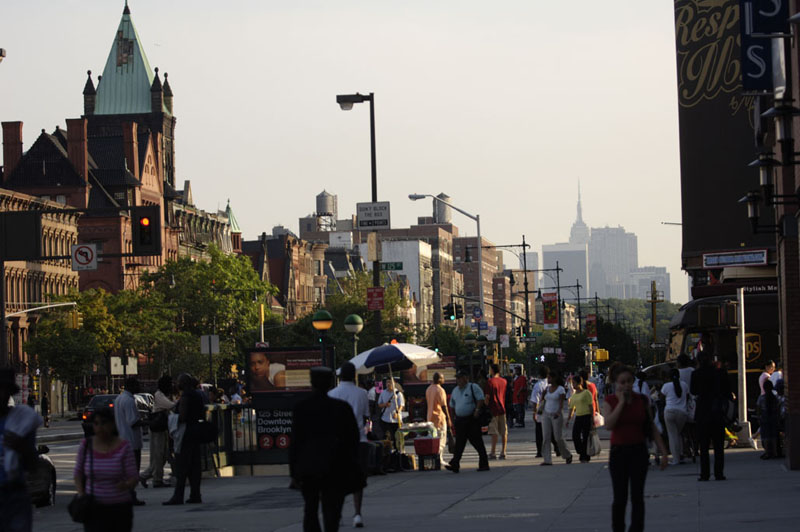
 Office of Climate and Environmental Justice311
Office of Climate and Environmental Justice311 Search all NYC.gov websites
Search all NYC.gov websites
Urban Sustainability
About Urban Sustainability
Sustainability means the activities we undertake today will not compromise the present generation’s or future generations’ ability to meet their own needs.
It is grounded in the recognition that people, economic development, and the environment are interconnected, and for any to thrive, all must thrive together. A sustainable city is connected by transportation systems that move people and goods to their destinations in a way that is both affordable and minimizes air pollution and greenhouse gas emissions. In a sustainable city, the air is breathable and the water drinkable. Waterways are clean and healthy food is available in any neighborhood.
The power system is efficient and dependable, meeting the demands of an expanding population without the greenhouse gas emissions that contribute to climate change. Buildings provide healthy environments, and are well designed for comfort and minimal energy costs. The small amount of solid waste generated is recycled, composted, and/or turned into energy without affecting air quality. Contaminated land from our industrial history is cleaned up to create housing, parks, and opportunities for new jobs. Parks offer spaces for children to play in and adults to walk around, trees provide shade and absorb carbon emissions, and are a refuge from the clanging and concrete.
To become the most sustainable big city in the world, we have to be conscientious of the resources we consume and the structures we build.
We have to innovate, because our density and island status create special conditions. And we must remember that what we do now will have lasting effects for generations.To become the most sustainable big city, we must all do our part today, for the sake of the future. Across the globe, greenhouse gas emissions are growing at an unprecedented rate, causing a rise in average global temperature and changes to climate patterns. In order to limit temperature increases this century to just 2°C and to avert the worst effects of climate change, as called for in the United Nation’s Framework Convention on Climate Change, we will need a 50 percent reduction in global emissions by mid-century—and up to an 80 percent reduction in developed countries.
New York City has signed on to meet this goal.
Cities must play a leading role in addressing the problem as more than half the world’s population now lives in urban areas, with cities generating the majority of the world’s emissions. Many cities, especially those concentrated in coastal zones that face increasing threats of rising sea levels, have recognized the urgency to act now to reduce emissions, regardless of national or regional climate policies.
We can take pride in the progress made to date toward our sustainability goals.
In a very short span since the end of the last century, we have already shaped New York City to be a model for the 21st century. Our city has its cleanest air in the last 50 years, and greenhouse gas emissions have dropped 19 percent from 2005 levels. We are but a few plantings away from the goal of a million new trees. Over 475 brownfield properties are being cleaned up and readied for new development, which is expected to bring 3,850 units of affordable housing. Our harbor is now the cleanest it has been in the last century. More than 500 miles of sewers have been constructed, or rebuilt, and we are activating a third city water tunnel to provide critical infrastructure redundancy to our water supply and the opportunity to repair older tunnels.
Much of this work has stemmed from the emphasis on sustainability embedded in past PlaNYCs, and was enhanced by the initiatives developed since 2014. New York City has firmly established itself among the community of global urban leaders in sustainability. We share this leadership with the most progressive capitals of commerce and culture in the world, but there remains much more to be done if we are to stake our claim as the most sustainable big city in the world.
As New York City continues to grow, meeting sustainability objectives will become more challenging. We are consuming more goods and resources, and consequently risk generating more waste and pollution. Our businesses and lifestyles, the engines of our economy and the products of our creativity, also require increasing amounts of energy, most of which is still derived from carbon-intensive fossil fuels. Continuing combustion of fossil fuels compromises our air quality goals—adversely affecting vulnerable populations and neighborhoods—and our ability to reduce our emission of greenhouse gases that result in global climate change. New sites to develop are becoming increasingly scarce, and the basic services needed to support a city, from water to power to sanitation to transportation, are becoming increasingly strained under the weight of a growing population and aging infrastructure.
We must figure out how all New Yorkers can sustainably and affordably live in clean, healthy environments. In building on the good work of our predecessors, we must enlarge the scale of our efforts to match the boldness of our ambitions.


